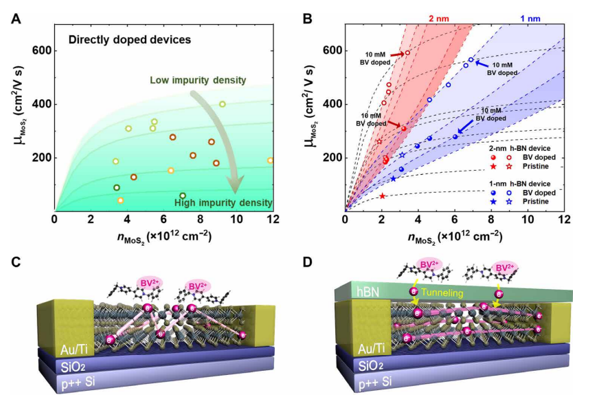Temperature-dependent measurements on remote charge transfer doped MoS2 FETs
To confirm SCTD in the MoS2 devices, two-point probe electrical characterizations were performed in a temperature-variable probe station (MSTECH, M6VC) using a semiconductor parameter analyzer (Keithley 4200-SCS). Keithley 4200-SCS with a pre-amplifier was used to measure the voltage drop across the channel by applying constant dc bias for four-point probe measurements.
The temperature-dependent measurements of the directly and remotely doped FETs were carried out with a cryostat system (CS204*I-FMX-12, Advanced Research Systems).
Figure 1. Temperature-dependent mobility values of (A) directly doped, (B) remotely doped devices with a 1-nm h-BN interlayer, and (C) remotely doped devices with a 2-nm h-BN interlayer at temperatures from 10 to 300 K.
Identifying suppression of charged impurity scattering in remote doping
Theoretical models were introduced for calculating the mobility of directly doped and remotely doped MoS2.
The charged impurity-limited mobility (μimp) was calculated as a function of carrier concentration for different impurity concentrations.
It was confirmed that the experimentally determined mobility of the remotely doped devices demonstrates a steep increase with the carrier concentration.
Figure 2. Experimentally determined mobility (μMoS2) and calculated mobility (μimp) as a function of carrier concentration (nMoS2). The μimp values are calculated for (A) direct doping (green lines) and (B) remote doping (blue lines for the 1-nm h-BN interlayer and red lines for the 2-nm h-BN interlayer) for different impurity concentrations. μMoS2 and nMoS2 values of remotely doped devices with the 1-nm (2 nm) h-BN interlayer are plotted as blue (red) circles and their pristine values are plotted as blue (red) stars, determined at 10 K to minimize the contribution of the phonon scattering. The schematic images of (C) the directly doped device, and (D) the remotely doped device in which the h-BN interlayer suppresses the charged impurity scattering induced by the remote BV2+ dopants.

